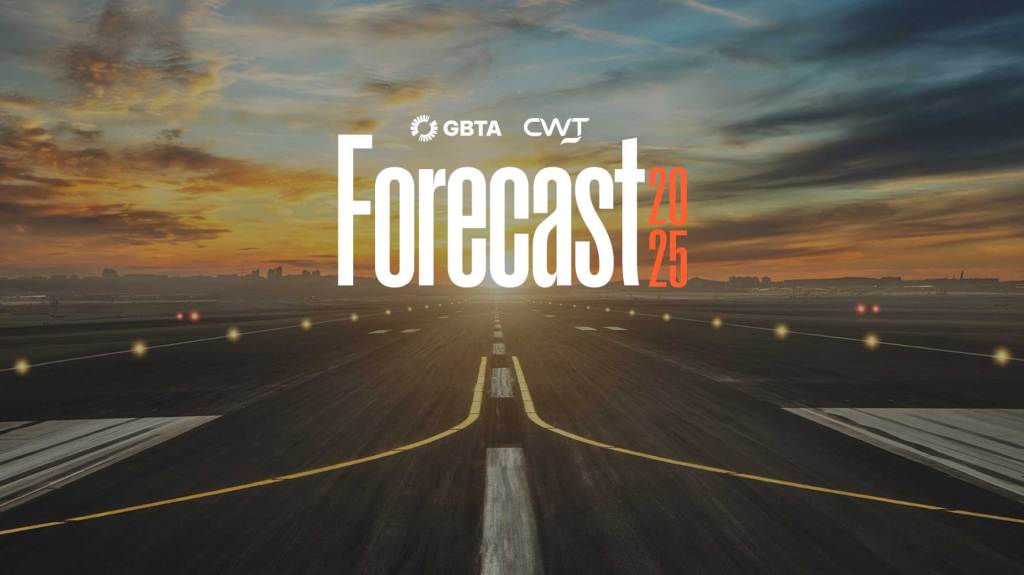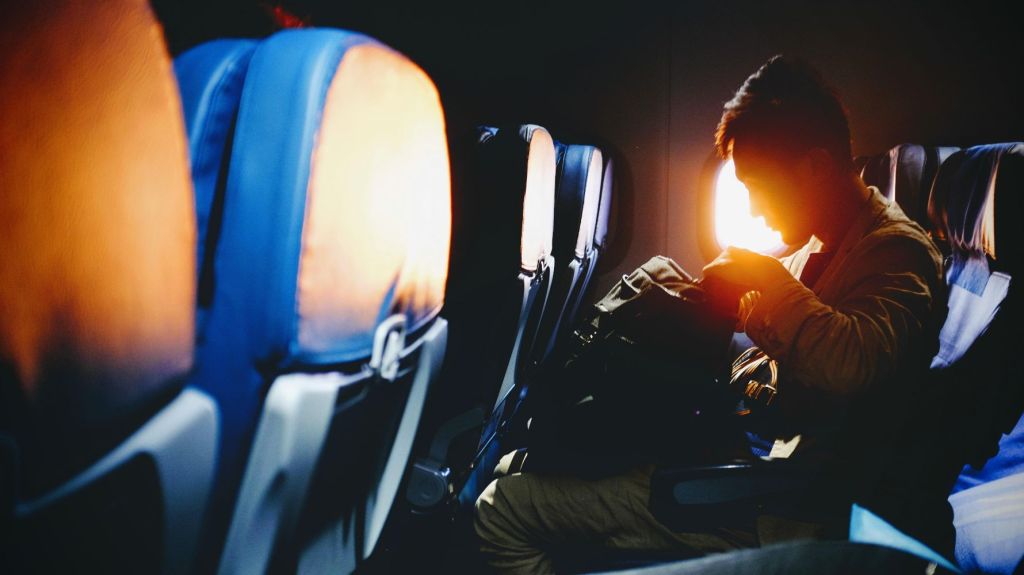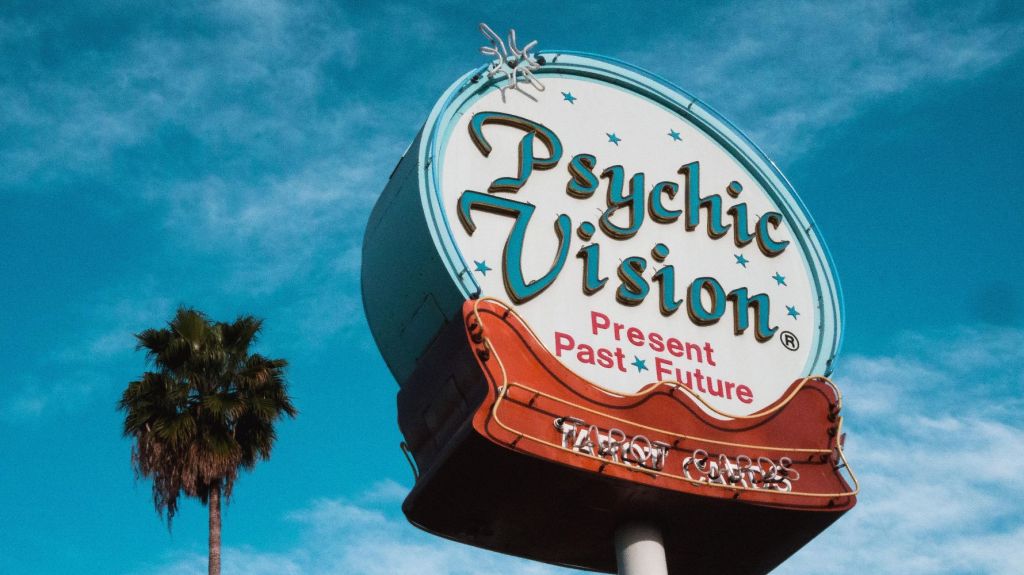Introducing the latest myCWT product and service enhancements
Building on our digital, omnichannel myCWT platform, our new products and services will simplify travel management for you and your employees – anytime, anywhere, anyhow.
Note: Featured services may not be available in your country at this time. Please reach out to your CWT representative for more details.
Hear from Chief Product Officer, Erica Antony as she shares the key product highlights of 2024, along with the key areas driving innovation.
-

2040: Baseline, Boom or Bust
As we enter an era of rapid transformation and unprecedented challenges, it is essential for travel managers, meeting & event planners, and corporate decision-makers to look ahead and frame our current strategic thinking with a clear vision of the future. Business travel and meetings and events (M&E) are poised for significant change over the next decade and a half, driven by a complex interplay of sustainability goals, technological advancements, evolving work models, and geopolitical dynamics.
In this paper to mark the 10th anniversary of our Global Business Travel Forecast, we explore, for the first time, a long-term vision of the future and potential trajectories through three distinct scenarios, each offering insights into how these forces should affect policy-making, budgeting and priorities. By examining these scenarios, we can better understand the diverse possibilities that lie ahead and the strategic imperatives required to thrive in each potential future.
Based on trajectory data analysis and interviews with industry leaders, behaviorists and climate tech founders, this forward-looking approach enables us to anticipate changes, strengthen our strategies, and make informed decisions that align long-term objectives. It is through this lens of foresight and adaptability that we can build resilience, seize opportunities, and navigate the complexities of the future.
We invite you to reflect on the insights presented, and consider how your organization can prepare for the opportunities and challenges that lie ahead. Together we can ensure that travel and meetings remain catalysts for growth, scalability and sustainable practices.
- Scenario development is both an art and a science
- Megatrends Shaping the Future of Business Travel, Meetings and Events
- Sustainability goals the new crux of corporate policy
- Technology Revolutionizes Travel Management
- Modern work models spark new travel patterns
- Changing demographics open doors to new opportunities
- Three Scenarios: Base case, boom and bust
- Future-proofing strategies

-

CWT GBTA Global business travel forecast 2025
When it comes to pricing, global business travel has finally reached an enduring, higher baseline. Prices will continue to rise in 2025, but only moderately, so expect a period of normalized growth.
However, this pricing environment, one of marginal gains and price regularity, is fragile. Global leisure travel has now realized a lot of its pent-up demand, while corporate travel has been resurgent, with 2024 edging at preCovid levels.
There are many factors at play, whether its volatile oil prices, labor costs and constraints, inflationary pressures, and geopolitical factors. As this elevated baseline edges upwards, albeit marginally, travel budgets will come under increased scrutiny, especially as travel patterns and attitudes change.
It’s why business travel can’t be viewed in a silo, and the true value to an organization must be fully realized. This forecast can help with those calculations.

-

Capitalize on emerging technologies in corporate travel
Technological advancements are accelerating at an unprecedented pace. How will emerging innovations like Generative AI, blockchain, and self-sovereign identity (SSI) transform corporate travel?
BTN and CWT probed global CEOs, travel managers, industry consultants and tech experts on the promises, questions, and expectations these innovations raise and how they are set to reshape traveler experience, cost control and service delivery in corporate travel and events.
Download and discover
- The technologies that will have the greatest impact on corporate travel in the next 2-5 years
- How these emerging technologies are poised to control costs, enhance service and security, and boost efficiency
- The critical challenges, opportunities, risks and roadblocks each innovation raises
- What travel managers, buyers and experts anticipate from these innovations

-

Passport to the future: Can blockchain revolutionize business travel?
It’s tempting to dismiss Bitcoin, the world’s first digital currency, as a passing fad, and nothing to do with the world of business travel, but what if the technology upon which it is built could make the fear of forgetting your passport, a problem of the past? Well, now there’s a brave new world.
While cryptocurrency is the most recognized application of Blockchain, the technology itself has the potential to revolutionize our lives, including making travel more streamlined and secure.
Essentially a decentralized and transparent data network, Blockchain was created as a way to shift power away from relational databases that are controlled by companies. The technology stores information in encrypted blocks that can never be changed or modified. Chaining the blocks together creates the blockchain.
It’s particularly relevant now, as high-profile data breaches have recently come to light. According to CNN, data is now a $300 billion a year industry.
From decentralized social networking sites to authenticated voting, companies are developing ideas across all industries. According to the World Economic Forum, it’s predicted that by 2025, around 10 percent of global GDP will be generated using blockchains.
But as with anything, looking at how complicated technology can solve everyday problems is where the real interest lies.
Our technical experts, Marcus Bonner and Jon Har-Ewen are testing possible applications by implementing POC or ‘proof of concepts,’ which involve using blockchains to solve small problems, and then gradually expanding on them. The advantage of working this way is that we can be flexible in introducing and testing new versions, and is just one example of the way we’re becoming much more fleet of foot in the way that we develop and release products.
The possibilities for how Blockchain can impact travel are numerous.
Starting with identify verification, a traveler’s identity could be verified from anywhere, eliminating that awkward exchange with passport control, when you look nothing like your photo. An application that distinctly assigns passengers to luggage is also being explored.
When it comes to loyalty and bonus programmes, reward points could be collected from vendors, and made instantly accessible and used like a currency.
If you sprain your ankle on a business trip, blockchain could streamline the error-prone process of logging a claim. A hospital could post the incident, which can be picked up from a block shared with an insurance company.
Blockchain has enormous potential but there is also some hype. Whenever there is a physical process involved, having a reliable database will help to track but will never eliminate human error.
However, it has the potential to address some of the issues associated with traditional systems, since it creates an encrypted thread of data ledgers. Travel managers can, therefore, fulfill their duty of care obligations more efficiently. In addition, travel management companies will be better placed to overcome unexpected problems and negotiate multiple levels of security, payment, and accommodation.
Changes to business travel are just around the corner but Blockchain is simply the connectivity piece. Our job is to build the future on that ecosystem.
-

Do your ding: 3 steps to an unforgettable business event
“I want to put a ding in the universe,” said Steve Jobs, one of the most innovative people the world has ever known.
“Good for him,” you might be thinking. “I’m trying to plan a conference, not create the next Apple.”
You’ll still want to put a “ding” in the hearts and minds of your attendees, though. By far the best way is to forget about what the competition is doing – and get creative.
In Blue Ocean Strategy, Renee Mauborgne argues that firms need to go beyond the mere improvement of products and services. They need to create new markets and opportunities, thus making competition irrelevant.
Her advice is more relevant than ever, as fierce competition meets the “experience economy.” A 2017 survey by Eventbrite states that three out of four U.S. millennials prefer to spend on experiences, rather than things.
It’s a cut-throat world out there. If you want to stand out, shake up your corporate do and take inspiration from other industries.
First up: the build-up.
Ditch the Outlook Calendar. An immersive cinema company in London creates 360-degree participatory worlds where attendees are asked to arrive dressed to a theme, and the venue is filled with actors. Everything’s top secret until the big reveal.
There’s no need to scare people, though. No one likes an Eyes Wide Shut scenario. Just add one element of mystery such as a secret location.
Second, introductions.
You know the drill. You arrive at an event and stand around like a meerkat, then squint at someone’s illegible ‘Hello, My Name Is’ sticker, before making an awkward introduction.
Look to transformational retreats for mind-blowing ways to introduce strangers.
One creative workshop leader does it like this: he begins by dividing participants into two rows, facing one another. He then invites one row to choose a partner from the opposite row. They must be the person that least sparks their interest.
The partners then sit knee-to-knee and spend seven minutes staring at each other without breaking eye contact. The exercise is then followed by one minute, each, of describing the experience. Such an introduction allows attendees to go beyond the superficial and find a connection in non-verbal communication.
Third, corporate souvenirs.
How many branded USB sticks and company pens does anyone really need? Although, one doctor recalls receiving a branded rectal thermometer at a medical conference, which was a first.
Give people something they might want to keep, by looking to the wedding industry. Try personalized mini bouquets of flowers, frosted donuts in your brand colors, or hire a photo booth with props.
So, don’t try to beat the competition. Compete against yourself. And focus on creating an unforgettable event.
-

CWT Meetings & Events appoints Sam Lay as Senior Director for Asia Pacific
CWT Meetings & Events, Carlson Wagonlit Travel’s meeting & events division, has appointed Sam Lay as Senior Director for Asia Pacific. He will report to Cindy Fisher, Senior Vice President and Global Head, CWT Meetings & Events.
Based in Singapore, Sam will lead a team of meetings and events (M&E) specialists across key markets in Asia Pacific. He will be responsible for expanding CWT Meetings & Events’ business in this high-growth region by creating engaging and memorable events for clients, while helping them maximize the return on investment on their M&E spend.
“Asia Pacific is the fastest growing region globally for CWT Meetings & Events, and I’m excited to have Sam join our team,” said Cindy Fisher. “Aligning corporate travel and M&E programs to better consolidate spend with suppliers is becoming a key priority for organizations here. Sam’s extensive knowledge and experience, combined with CWT’s investment in the latest data and digital solutions, will help our clients optimize their M&E spend while delivering best possible attendee experience.”
Sam brings more than 17 years of experience in the M&E industry, having worked at organizations across the value chain including the Singapore Tourism Board, MSD and Suntec International. At Suntec International, he led the planning and development for several new convention projects in Asia. Prior to joining CWT Meetings & Events, Sam was Senior Director for Greater China at BCD Meetings & Events.
Professionally accredited as a Certified Meeting Professional (CMP) from the Convention Industry Council, Sam holds a bachelor’s degree in international tourism from James Cook University in Australia. He is also a graduate of the Singapore Armed Forces Staff and Command College.
CWT Meetings & Events
CWT Meetings & Events (M&E) is an award-winning global corporate events management service. Representing all industry sectors, CWT M&E delivers comprehensive live, virtual and hybrid event solutions for thousands of customers every year. Ranging from end to end productions of some of the world’s largest and complex global conferences, through to intimate national teambuilding experiences.
Follow us on LinkedIn, Facebook and Twitter.
About Carlson Wagonlit Travel
Companies and governments rely on us to keep their people connected. We provide their travelers with a consumer-grade travel experience, combining innovative technology with our vast experience. Every day we look after enough travelers to fill almost 200 Boeing 747s and around 100,000 hotel rooms, and handle 95 corporate events. We have more than 18,000 people in nearly 150 countries, and in 2016 posted a total transaction volume of US$ 23 billion.
-

The sharpest tool in the box: Why TMCs make the best data partner
Large, complex travel programs often require significant data processing, integration, and analytics. Many integrate travel, card and expense data to understand expenditure, tackle off-channel spend and manage suppliers.
Sometimes travel managers will look to systems integration services and/or analytics tools for help. But TMCs – like CWT – can actually be a better option. To see why let’s look further at the example above.
To integrate card, expense and travel data and realize the full business benefit, you need to do three things:
- Physically integrate, consolidate and clean the data.
- Analyze the data – with respect to business processes, suppliers and actions taken by travelers and approvers.
- Turn your insights into actionable business process enhancements and change.
Large TMCs can help with all three:
- Data Integration – this is the technical work of getting data from your systems and those of your suppliers into the reporting and analytics systems. The core service here is data integration. That includes the consolidation of data onto a single platform for analysis, but also the cleaning, feed set-up and maintenance, data code dictionaries, error trapping and messaging, data extraction, transformation and loading. Data-integration service companies are often the go-to suppliers in this space. But they’re not travel industry specialists and will often struggle with the data, since they lack the domain knowledge to really work with it. A TMC that offers data integration services – like CWT – can combine those with their specialist knowledge. That’s likely to make the integration stage much more successful.
- Reporting and Insight – this is the data analytics, data science, predictive analytics, reporting and related software and services. Specialist analytics companies dominate this space. However, knowledge of the industry, travel manager needs and data knowledge are critical to get the analytics working properly. A number of TMCs are also starting to offer products and services here because their domain expertise is in demand. Some are even offering analytics software solutions.
- Operationalisation – by this we mean taking the results of reports and insight and turning that into new business processes, actions or their useful business activity. This is where a large TMC can be of particular benefit as they have the deep experience around the business processes needed to make the changes the data insights suggest. Larger TMCs have huge client bases on which to base their experience. This helps the travel and procurement managers to turn insight into successful business change.
TMCs are great data partners because they know you and what you’re thinking. Being right at the heart of the industry, they can help you avoid the errors, delays and half-baked solutions you risk in using “pure” data players.
The bottom line is this: businesses don’t buy analytics or data integration – they buy improvement. Choosing the optimal supplier or combination of suppliers is critical to converting your data into savings, happier travelers, and smarter travel programs.
- Physically integrate, consolidate and clean the data.
-

Watch out, Nostradamus! – Futurology for Travel Managers (2/2)
In Part One, I looked at the concept of predictive analytics and some common pitfalls. Now I’m going to give you some real-world examples of predictive analytics for travel managers.
Predicting Behavior
This is already being done routinely – Amazon does it to you every time you log in: “people like you bought stuff like this.” Human beings are surprisingly predictable and you can leverage this as a travel manager, using the same techniques.
For example, adherence to travel policy is a function of demographics, job grade and travel experience. It’s not rocket science but when modeled correctly it can generate savings and improve efficiency. You can nudge the naughty – and leave the nice alone.
Compliance is not the only behavioral predictive application – travel preferences, personalized booking experiences and auto-generated predictive itineraries are really not all that different from what Amazon does every day.
Predicting waste
CWT Solutions Group recently conducted a study with over 10,000 respondents. The aim was to understand what constituted a successful trip and therefore work out wasted travel spend. Roughly 12% of all trips are considered failed by the travelers themselves. Why? Mostly bad planning.
- Advance booking: The longer the trip is booked in advance, the less likely it is to fail. A trip booked less than 3 days in advance has a 21% chance of being unsuccessful. This reduces three-fold when booked and planned 15 days in advance.
- Number of meetings: A trip with only one meeting produces an unsatisfactory result 19% of the time. If you want a rule-of-thumb, every additional meeting in a trip reduces the probability of an unsuccessful trip by about 10%.
- Time spent in meetings: In 38% of the unsuccessful trips, the cumulative meeting time was four hours or less. When that’s an hour or less, the probability of an unsuccessful trip is 28%.
Predictive models for trip success (and spend value) can be incorporated into the trip approval process by looking at the above three factors. Simply insisting that each trip consists of at least two meetings and has at least 4 hours of total meeting time can cut wasted travel by over a quarter, creating significant savings.
Predicting Spend
Here, the key is to understand how travel expense correlates with the business itself. Don’t assume next year will be like this year. Moreover, different parts of the business will respond to changes in the business environment and performance differently than others. And you want your predictions to be in line with business planning.
To do this, you need to identify the key performance indicators for the business, correlate those with travel expense in each cost center, and get a prediction on those KPIs.
To make this work, you need historical data with matching expenditure. As for the KPIs, management types routinely come up with those to run the business. Right or wrong, it’s best to use those KPIs because, regardless of what actually happens, your planning will be in synch with business planning across the organization. If you work for a large organization, you can repeat this for each unit.
Again, not rocket science – very transparent and easily explained. Travel expenditure is a function of business activity. All businesses generate KPI forecasts for planning purposes and there is no reason not to use those. What I am advocating here is to be smart about it – leverage the fact that different parts of the business will respond differently to business change. Use historical data and some statistical modeling to understand those relationships better so your own expenditure forecasts are more accurate.
The bottom line: there are some smart ways you can apply predictive analytics to corporate travel. The key is to be realistic about what you’re predicting and ensuring you have the right technical skills in your team. There is no mystery to predictive analytics. People do it all the time. You should, too.
Read also part 1: Watch out, Nostradamus! – Futurology for Travel Managers (1/2)
-

Watch out, Nostradamus! – Futurology for Travel Managers (1/2)
Predictive Analytics is like the afterlife – everybody likes the idea of it but nobody knows what it is. I’d like to help clear this up. To do so, I will show you how travel managers can use predictive analytics.
In this first instalment, I’ll walk you around the challenges of predictive analytics. Next, we’ll get into how corporate travel managers can use it to improve travel programs.
What’s predictive analytics – and why am I not a billionaire?
The short definition is “using modelling to predict the future.” It can be simple: you take what’s happening now and assume that it will continue. It can also be more complex – looking at human behavior and predicting how that will change.
Predictive analytics is easier when looking at people and known processes – harder when predicting things like economics. In fact, if you can reliably predict your company’s earnings, quit your job and join a hedge fund, congratulations – you are about to become a billionaire! In fact, if anybody comes to you saying they can predict the numbers and they’re not fabulously rich, then they’re either lying or selling you something – and that something is not a good economic prediction model.
What I am saying here is be realistic – avoid predicting economics and focus on things that you understand and where a good predictive model will plausibly work. The good news is there are plenty of areas in travel management in that sweet spot.
However, there’s a wrinkle: the very act of predicting the future … changes it.
The Future Paradox
The past is fixed. It’s not going to change. The future is up for grabs. So simply predicting the future may change it.
Why? Because when you predict the future, people will act on that prediction. That not only changes the future, but like something straight out of the Twilight Zone, the prediction can cause precisely the opposite to happen – even if your original prediction was correct in the first place!
Here’s a simple example: say I create an app that can predict airfare prices with 100% accuracy. I sell you the app. You’re flying from London to NY in a month and the app says to buy your ticket in two weeks, that’s when prices will be lowest. It works a treat. And you’re a happy customer.
However, I sold it to lots of others, too. Now everybody waits two weeks. Then, on the very date the app predicted prices will be lowest, everybody books. Now think: what happened to prices when nobody was buying? They went down. And on the day everybody is buying, prices rocket. So: accurately predicting an event can cause the exact opposite to occur because too many people acted on the prediction.
Wait – is this really useful … or should I just move on to the next fad?
The good news is that there are some useful applications of predictive analytics in the travel space that won’t cause paradoxical tears in the space-time continuum.
The trick is look for things that are what I would call understandably predictable. In short, if you can see why a given piece of predictive analytics works, it’s probably a keeper. In other words, it should be clear why it should hold in future – regardless of whether the prediction is widely acted upon.
Some examples of this are traveler behavior, wasted travel and expense. Next, I’ll discuss how you can make it work.
Read also part 2: Watch out, Nostradamus! – Futurology for Travel Managers (2/2)
-

Beyond traditional hotel security – Helping business travelers stay safe
Assessing traveler’s safety at hotels
When we think about how safe travelers are at a hotel, we often think more in terms of physical security.
Is the hotel security up to local safety regulation standards? Are there working fire extinguishers and well-marked fire exits? How accessible are the room doors to the public? Are the windows secure? Who has control of the room keys? All of these are certainly important questions, but they only address a portion of the security considerations travel managers should be making on behalf of their travelers.
Most overlooked safety factor: Location of the hotel
To begin with, the location of the hotel is one of the most overlooked yet highly impactful safety factors. If you have not performed any location assessments, it’s good to start on a wide scale and from there narrow down your analysis.
Begin by using TMC or third-party security tools to assess security threats at a country level. You can quickly determine whether an entire country, or even part of a country has elevated security risks.
But really you should be digging deeper and assessing risks at a more micro scale. A nice hotel may be in a safe neighborhood that is abutting another, higher risk area. If travelers aren’t very familiar with the city, they may not realize that walking out the door in one direction can be significantly more dangerous than going in the opposite direction.
Here are some tips for higher risk areas:

Use a car service (consider this addition to your travel policy)

Avoid street food

Keep the hotel’s business card on you (with hotel name and address on it)
Use security tools to share safety information with employees, such as crime spots to avoid and safer zones that are ok for going out. You can also provide the safest routes between the airport and their hotel or from their hotel to meetings and events.
You should also rely on local employees to verify if hotels are in safe neighborhoods. At the very least this information can help reduce the stress of travel and facilitate timeliness to meetings, which travelers will appreciate.
Hotel “Safe Havens”
If an emergency does take place, the hotel can be one of the best “safe havens” for your travelers. This means the selection of a hotel is paramount in keeping travelers safe. Picking a “safe haven” hotel certainly requires checking its physical security measures, such as security fencing, cameras, and security guards, but, again, security goes beyond these physical aspects.
Hotel staff can be very helpful in dangerous situations. They should be very familiar with the area and able to provide more localized, up-to-date information during an incident. You should use GBTA security screenings to ensure the hotel staff is multilingual and able to answer your traveler’s questions in emergencies. The staff should also be well informed about the hotel’s emergency protocols, and ideally a hotel will also have a dedicated security team ready to intervene or involve authorities as needed.
Wi-Fi is always an important amenity for general business purposes, but you should view it as a security feature as well. A “safe haven” is one that keeps travelers connected. Wi-Fi access is the best way to make sure travelers can stay informed and in communication.
Safety Tips for all Travelers
Regardless of a country’s risk level, it’s a good idea to send out and post general hotel safety tips, such as:
- Don’t discuss room numbers out loud
- Try to be up early and back early
- Don’t walk alone
- Learn local customs in order to not to offend anyone
- Request rooms on floors 3-7
- Check room locks are working
Here are additional tips more specific to female travelers:
- Wear conservative clothing
- Don’t open door to anyone if you aren’t 100% certain who it is
- Be conscious of signs you’re alone, like leaving a tray with a single wine glass outside your door
- Try to exit the hotel at the same time as other people
We also offer this more comprehensive checklist of security tips for you to download and give to your travelers.
-

Carlson Wagonlit Travel appoints Catherine Maguire-Vielle as Chief Human Resources Officer
Former SVP & Assistant General Counsel also appointed to Executive Leadership Team
Carlson Wagonlit Travel (‘CWT’), the global travel management company, today announced the appointment of Catherine Maguire-Vielle as Executive Vice President and Chief Human Resources Officer (‘CHRO’). Former CHRO David Moran has decided to leave the company and will do so in early April.
“I am delighted that Catherine will be leading our efforts to continue to build a culture of innovation, empowerment and performance,” said Kurt Ekert, CWT President and Chief Executive Officer, “and I thank David for his impact and many contributions throughout his career at CWT.”
Catherine is based in Paris, and will report to Kurt as a member of the CWT Executive Leadership Team. She was formerly Senior Vice President and Assistant General Counsel with CWT.
Catherine gained a Bachelor of Laws from the University of Sheffield and completed her professional legal qualifications (LPC) at the College of Law, in York, England before joining international law firm Clifford Chance in 1999, where she worked in both their London and Paris offices. She joined Carlson Wagonlit Travel as Director & Senior Corporate Counsel in 2006.
Carlson Wagonlit Travel
Companies and governments rely on us to keep their people connected. We provide their travelers with a consumer-grade travel experience, combining innovative technology with our vast experience. Every day we look after enough travelers to fill almost 200 Boeing 747s and around 100,000 hotel rooms, and handle 95 corporate events. We have more than 18,000 people in nearly 150 countries, and in 2016 posted a total transaction volume of US$ 23 billion.
-

Jet, set, go: How data science can make business travelers happier and more productive
Almost everyone who has traveled for work can recall a time when they arrived at their destination dog-tired and woefully unprepared.
If a significant amount of your mental energy is spent hailing a cab to the airport at 5 am, or trying to finish a presentation during a layover punctuated with shrill flight announcements, you’re not going to be at your best when you walk into that important meeting.
In fact, stressful travel experiences can wreak havoc on a company’s finances. According to a Harvard study, lack of sleep leads to the loss of 11.3 days’ worth of productivity every calendar year.
Spending more where it matters makes sense. In practice, that means looking beyond marginal savings on things like flights.
Complicated itineraries may be fine for a teenage backpacker – where the journey is the destination – but not for a salesperson tasked with clinching The Deal.
If the cheapest ticket involves a dawn flight and a layover, that salesperson could land in Lagos or Ankara, tired and resentful – knowing they could have taken a non-stop flight at a sensible hour. Those 100 euros “outside the travel policy” condemned them to the flight from hell. That’s a false economy.
Several zeros worth of lost business can be tacked onto that 100 when the salesperson fails to clinch the deal.
Our data scientists look at ways to help clients avoid losses, concentrate their spend, and ultimately balance the budget with health and happiness.
By looking at data sets such as sickness information from HR systems, for example, fascinating patterns in human behavior can be measured – in ways that are persuasive to decision makers (i.e. hard cash). For example, you can look at HR data around sick leave. If your top people are on that red eye to Tokyo every week, eventually they will get sick and need time off – that’s a fact. The data will tell you when you need to ease off on the travel – and what policies are best for productivity.
The possibilities are endless. We can use data to plot cost versus profit, incentivize people to follow the rules, understand when travelers drop out of the booking process and tweak policies to help parents, attract talent, and increase diversity.
Data science provides an unprecedented opportunity to make travelers happier and more productive – and companies more profitable.
-

Blades of glory: Say hello to the World Figure Skating Championships in Milan
Aside from the fact that we are very proud our company has been entrusted with the organizational management of the World Figure Skating Championships, this reminded me of one of the golden rules of event management – book early to avoid disappointment.
And by that I don’t mean the event itself – although it has been years in preparation and it will be exceptional viewing. I mean companies, or travelers, visiting Milan from 21 to 25 March 2018, when it is taking place.
As with any big event, sporting or otherwise, the host city and country reap many economic benefits, and hotel room rates and availability are always at a premium.
If you are planning a business meeting which coincides with something like this, plan ahead and book your accommodation in plenty of time. And maybe even think about incorporating it into your agenda – as the analogy between sporting and business excellence is a well-known motivational tool.
So, what are you waiting for? Get your skates on.
-

CWT Meetings & Events awarded World Figure Skating Championships 2018
CWT Meetings and Events, Carlson Wagonlit Travel’s meetings and events division, has been selected by the International Skating Union (ISU) and the Italian Ice Sports Federation (FISG) to run the ISU World Figure Skating Championships 2018, which takes place at Milan’s Mediolanum Forum di Assago on 21–25 March.
M&E Sport, the events specialist dedicated to sporting events within CWT M&E, will coordinate the complex logistics of the five-day event, including PR and marketing. M&E’s involvement extends to overseeing the construction of the skating rink at Piazza Gae Aulenti, and the presentation of the Gala Dinner at the breathtaking Palazzo del Ghiaccio.
“This is an extraordinary opportunity to combine sporting passion with the values of Made in Italy,” said Stefano Abram, GM of the Organizing Committee, “I am pleased to work with an experienced, reliable partner like CWT M&E. Hosting a World Cup in Italy is a dream come true for those who live sport and its values.”
“Working to successfully deliver an International event at the heart of one of the most dedicated sporting communities is a once-in-a-life time opportunity,” said Raffaele Calia, head of Sales and Marketing at CWT Meetings & Events and M&E Sport.
The ISU World Figure Skating Championships is yet another addition to CWT M&E’s fast-growing roster of events in the world of sports. CWT M&E already partners with UEFA, Dorna, and the Italian National Olympic Committee, for whom it just organized ticketing, logistics, and hospitality at the Pyeongchang Winter Olympics in South Korea.
CWT Meetings & Events (M&E) is an award-winning global corporate events management service. Representing all industry sectors, CWT M&E delivers comprehensive live, virtual and hybrid event solutions for thousands of customers every year. Ranging from end to end productions of some of the world’s largest and complex global conferences, through to intimate national teambuilding experiences.
Follow us on LinkedIn, Facebook and Twitter.
About Carlson Wagonlit Travel
Companies and governments rely on us to keep their people connected. We provide their travelers with a consumer-grade travel experience, combining innovative technology with our vast experience. Every day we look after enough travelers to fill almost 200 Boeing 747s and around 100,000 hotel rooms, and handle 95 corporate events. We have more than 18,000 people in nearly 150 countries, and in 2016 posted a total transaction volume of US$ 23 billion.
-

“Hey, CFO! Hands off my travel budget.”
Travel budgets are constantly under pressure – often severe pressure. That’s because travel is often in the top five costs. So when the CFO looks for savings, all too often, travel winds up taking the hit.
How does a travel manager defend that pot?
Well, first, you need to cast travel as an investment with a return – not just a cost. This shifts the argument and puts you back on the front foot.
Business travel should be viewed in the context of operations, revenue streams and human impact. More to the point, organizations need to understand how business travel helps their corporate strategy – if you can show in clear, concrete terms how travel is critical to that strategy, you’re in a much better position.
However, you can go much further by measuring travel ROI directly, in quantifiable terms. For example, measuring and demonstrating the relationship between travel expenditure and revenue is a fantastic way to demonstrate travel ROI. That helps protect travel budgets but also provides arguments for expanding them.
The key is to combine traditional travel data (hotel, air, expenses) with HR, corporate finance and other non-traditional data sources, allowing you to view travel and travel policy as part of the whole.
One of the simplest ways to quantify ROI is to correlate travel expenditure to revenues. To do this, you need to match your travel data (travel, expense and card) with data on where the travelers sit within the organisation – ideally by cost code or cost centre. Once you have that, you should be able to get revenue information by cost code/centre. Granted, this won’t cover all travel but, for most businesses, it will cover a significant chunk. With these data – travel, organisational and financial – you can get a pretty good correlation between travel and revenue generation. If you can get historical data going back a few years, even better.

The aim here is to show the relationship between travel and revenue. If you can do this, it’s much harder to slash travel budgets – the last thing anybody wants to do is impact revenue.
The process above can be repeated for other corporate or departmental KPI’s such as growth, operational efficiency, effectiveness – wherever good, quantifiable data is available.
For many companies travel is the critical tool with which a large proportion of business and operations are conducted. However, as travel is often viewed as a cost and not an investment, it’s all too easily pruned back to the point where the savings are negated by the damage caused.
So: demonstrating the ROI on travel is the best way to keep flying.

